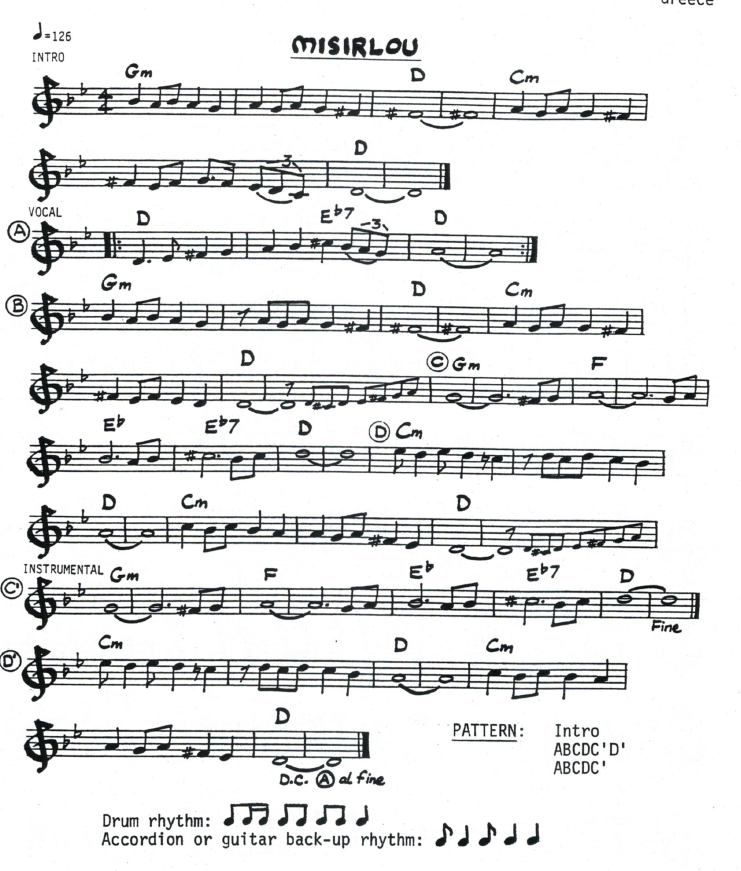You probably know it from Pulp Fiction, but it’s far older than that.
Indeed, that’s where I first heard it, so imagine my surprise when I heard it’s familiar melody on an old cassette that I’d borrowed from the library, sometime in the late ’90’s. I can’t remember what minimal notes there were about it in the liner, but it was vague. But now, my Google-fu is strong (sources at the end), so here’s what I found:
Misirlou (Μισιρλού) is a very old melody, originating from Greek “rebetiko” (folk music form). It is a song of a taboo romance – a Greek lover longing for his Egyptian girl. It’s popularity took it across the globe, and it’s been sung in at least eleven different languages, and like most very old folk music, it’s difficult/impossible to pinpoint the real author. Tetos Demetriades recorded this song in 1927, and Michalis Patrinos recorded it in 1930. Despite Demetriades having recorded it 3 years prior, it seems Patrinos tends to get the writing credit more often.
According to Second Hand Songs (a great resource for music sleuths), may have been based on an earlier song “Bint Misr” by Sayyed Darwish, which I have had zero luck in finding. (If you find it for me, I’ll bake you a pie.) If indeed, Misirlou came from Sayyed Darwish, then this would put the origin in Egypt… which is interesting, as Egypt has a distinct lack of Misirlou recordings (only one known recording, from the 1940’s).
The Library of Congress has two haunting recordings from 1939. Totally worth checking out.
Nick Roubanis got a writing/composing credit for it in 1941, although I don’t know if he actually was involved, or if he just happened to be smart enough to copyright it. Either way, Dick Dale had to pay royalties to him when he did his surf-guitar cover in 1962.
In the 1940’s Misirlou was being brought to North America to become a lounge classic (and later a surf-guitar mega-hit), but it was also being translated into Arabic and Yiddish. Clovis El-Hajj sang the only known Arabic version of Misirlou, which he called “Ya Amal”, in 1944. Seymour Rexite recorded (his wife) Miriam Kressyn’s Yiddish translation around 1950. Both of these have a classic, of-the-era sound to them, with tinkling piano and smooth crooning. Also notable in the Yiddish department, is a surprising recording of Rabbi Nuftali Zvi Margolies Abulafia. (You can learn more about him/that recording on this program.)
I haven’t been able to track down a recording date for Dario Moreno‘s French version, but my best guess is that it must have been in the 1950s, as the track appears on “best of” albums released much later than that.
Reuben Sarkisian translated Misirlou into Armenian, and recorded it as “Akh, Anoushes” in the 1950’s, but I haven’t found it yet. I did, however, find an Armenian version by Paul Baghdadlian, but I don’t have the recording date.
Between 1940 & 1960, Misirlou could be heard played by orchestras that dripped of that vintage, exotica, lounge-sound that many of us fell in love with again in the mid-1990’s. Xavier Cugat in 1941, and Martin Denny in 1960.
1955 gave us a spectacular doo-wop English version by The Cardinals. I have no idea what inspired them to cover it, but it is a serious winner in my book.
In the 1960’s, Misirlou enjoyed plenty of surf-guitar instrumental attention after Dick Dale’s iconic recording in 1962. The Beach Boys, The Ventures, The Astronauts, The Surfaris, The Trashmen, and The Bobby Fuller Four, all recorded Misirlou in & around 1963.
But Misirlou’s popularity spread beyond the surf-scene and the 1960’s also saw English versions by Chubby Checker and Connie Francis, and also, a very obscure Italian cover by Gino e Dorine, that just screams 1967.
The 1970’s brought us George Abdo’s Misirlou that would be loved by belly dancers for years to come. Also from this era, we find recordings from Turkey and Serbia, that have different names, but are Misirlou’s melody nonetheless. Turkish singer Zeki Müren recorded a fantastically Orientalist Yarali Gönül in 1971, and Staniša Stošić (the Serbian Pavarotti) recorded Lela Vranjanka in 1972.
I’ve found a current Ladino (Judeo-Spanish) version by Nataly Oryon, but don’t have a date.
My latest and most shocking discovery was that it’s also been covered in Hindi! For those who are unfamiliar with music in Bollywood movies: the actors are not the ones singing. The songs you hear sung in the epic and colourful dance numbers are sung by “playback singers”, and the actors lip-synch. This Misirlou-inspired “Raat Se Kaho Ruke Jara” for the film Lutera, was sung by one of the most famous playback singers: Lata Mangeshkar, and I *adore* her.
Perhaps my most favourite is this clip of a rather young Dick Dale playing live. His father was Lebanese, and I find moreso in this version than the studio release, the Middle Eastern flavour is very present and delicious.
Kids these days will recognize it as Pump It by The Black Eyed Peas, but we know better, right?
The earliest known lyrics, translated from Greek:
My Misirlou (Egyptian girl), your sweet glance
Has lit a flame in my heart.
Ah, ya habibi, ah, ya le-leli, ah (Arabic: Oh, my love, Oh, my night)
Your two lips are dripping honey, ah.
Ah, Misirlou, magical, exotic beauty.
Madness will overcome me, I can’t endure [this] any more.
Ah, I’ll steal you away from the Arab land.
My black-eyed, my wild Misirlou,
My life changes with one kiss
Ah, ya habibi, one little kiss, ah
From your sweet little lips, ah.


























